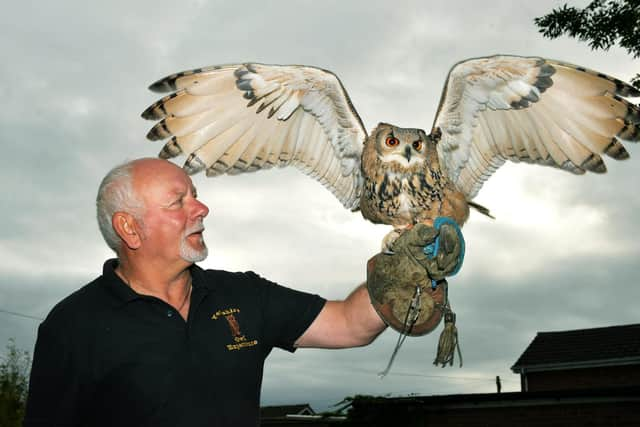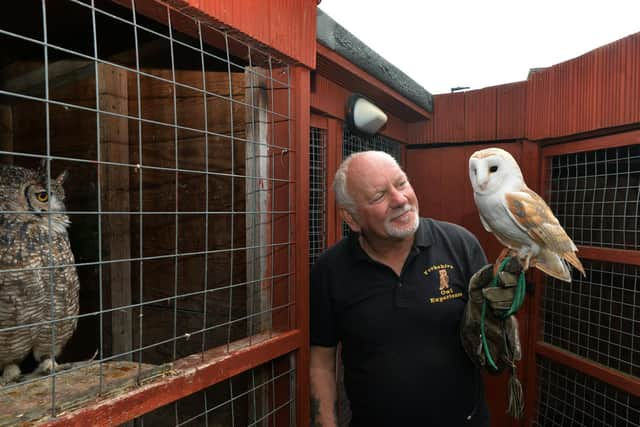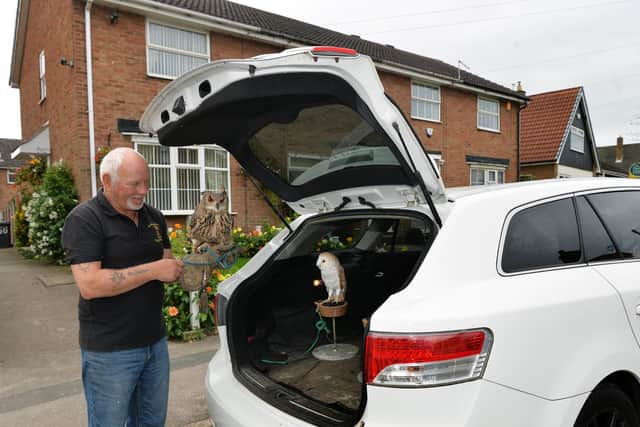Meet the Yorkshire 'owlman' who has spent his life nurturing birds of prey and now takes them into schools
Steve Arabskyj has run the Yorkshire Owl Experience from his home in Gawthorpe, neat Wakefield, since 2013 and makes regular visits to primary schools with a team of five of his birds.
Steve said it was his own experience when only 12 or 13 years old that brought about his interest and fascination for the birds.
Advertisement
Hide AdAdvertisement
Hide Ad“I’d finished playing football with my friends and on my way home I would normally cut across Mirfield Showground. One time I saw this big bird and thought it was a bit strange, so I sat and watched it.


“It was a tawny owl. It kept heading for the same tree, carrying food.
“Eventually, I waited until it flew off again to catch more and then I climbed up the tree to take a look. I saw three chicks in the nest and thought they looked really nice.
“I climbed back down and watched it come back. I continued going to the field and watching it going back and forth for a number of nights until one night it didn’t appear. I waited and waited and wondered about the chicks, because they would need feeding, and in the end I climbed back up and saw just one in the nest.
Advertisement
Hide AdAdvertisement
Hide Ad“I felt something wasn’t right. They weren’t big enough to fly and the mature tawny owl hadn’t come back at all.


“In my mind I wondered why two owl chicks might have been taken and this one left? Had a predator been? After waiting a long time to check that the mature tawny owl wasn’t around I decided to rescue the owl chick.”
Steve hand-reared the owl chick, but he said tragedy occurred when a cat got into the shed.
“The cat killed it. I was really sick at the time. It had been coming along lovely and I was creating a bit of a bond.”
Advertisement
Hide AdAdvertisement
Hide AdIt was to be many years before Steve was to return to keeping another owl, but he said he never lost his fascination.


“As a family we used to visit Lotherton Hall Bird Garden quite regularly where they had a good selection of birds, including falcons and owls.
“Around twelve years ago, having always kept my interest, and then single, I decided to get a couple of owls. I got an African Spotted Eagle Owl from an estate gamekeeper who kept owls and bought an Indian Eagle Owl from a breeder. You buy them generally from people who breed owls to sell to falconry centres or people like me who know something about them.
“They were both 14 days old. You take them on at that type of age because that way you can create a bond and build trust.
Advertisement
Hide AdAdvertisement
Hide Ad“That’s when they get what is called an imprint. These come in two types. If your chicks have hatched in an incubator and never seen their parents, you have a full imprint. It’s a social imprint if you take them on after they have been with their parents for a number of days.”
Steve said the catalyst for turning around what he’d thought was just going to be a hobby of keeping owls to becoming the Yorkshire Owl Experience and educating young and old came about through his daughter, Shay.
“Shay had a friend who was a teacher at a school in Outwood who asked whether I could take them in. To see the children’s faces was an amazing moment for me.
“I could see how much they were in awe of them. That first visit kicked off where I’ve got to today.
Advertisement
Hide AdAdvertisement
Hide Ad“Children might read about owls in school but to have a real owl and one that is flying about is exciting for them.”
Steve said he generally visits three schools a week, going in for an hour and taking with him a team of five of his nine owls.
“I’m mainly going into nurseries, reception year and years 1 and 2 classes. I also visit Brownie and Cub Scouts packs and Women’s Institutes, street fairs, rest homes and shows.
“I talk about each individual owl, explaining owls can be quite different due to their feathers and the kind of distances each will fly. Woodland owls, like tawny owls, little owls, short and long-eared owls are not big flyers and have softer feathers because they do a lot of sitting and waiting and need to keep warm.
Advertisement
Hide AdAdvertisement
Hide Ad“Eagle owls have strong feathers because of their greater distances in flight.
“Barn owls’ feathers are perforated to allow the air to go through so they don’t create a noise. If I let one of my barn owls fly over the top of your head I guarantee you wouldn’t hear it.
“I explain where each of the owls I’ve brought come from, what sort of habitat they would live in when in the wild, their food sources and how they make their nests.
“I will then fly the owls over the children’s heads pretending they are hunting and have seen a mouse. The schoolchildren then see the size of their wingspan.
Advertisement
Hide AdAdvertisement
Hide Ad“That’s a real wow factor. The star of the show is my little owl, which is the name of a breed, called Charlie.”
Steve said he thought he’d lost George, his female African Eagle owl, when he was training her in a field, but all ended happily and humorously.
“In training I usually have the perches, where the owl finishes its flight, in the middle of the field. This particular day I’d pegged them at the side of the field.
“After a couple of flights George had obviously had enough and set off over the trees.
Advertisement
Hide AdAdvertisement
Hide Ad“I’d thought to myself ‘oh no’ but fortunately she was still attached to her creance. As I approached my car, there she was sat on top of it waiting for me!”
Steve said that around seven years ago and after two or three really wet summers the barn owl population in the wild dropped.
“If it rains you won’t see barn owls out flying much because their feathers get clogged up and it affects their ability to fly. They become very noisy.
“Barn owls are amazing birds. I’ve watched them in the wild when the males will hunt in a field. They will go around the field at about 12ft above ground and they will listen to the noises.
Advertisement
Hide AdAdvertisement
Hide Ad“They will then go around again detecting the noise of a mouse. They can hear a mouse in the grass from there and they will stop in mid-air, hang like a kestrel using their eyes to locate, then drop, their talons so sharp they render the mouse immediately stunned.”
Steve’s father was from Ukraine and his mother from Italy.
Comment Guidelines
National World encourages reader discussion on our stories. User feedback, insights and back-and-forth exchanges add a rich layer of context to reporting. Please review our Community Guidelines before commenting.